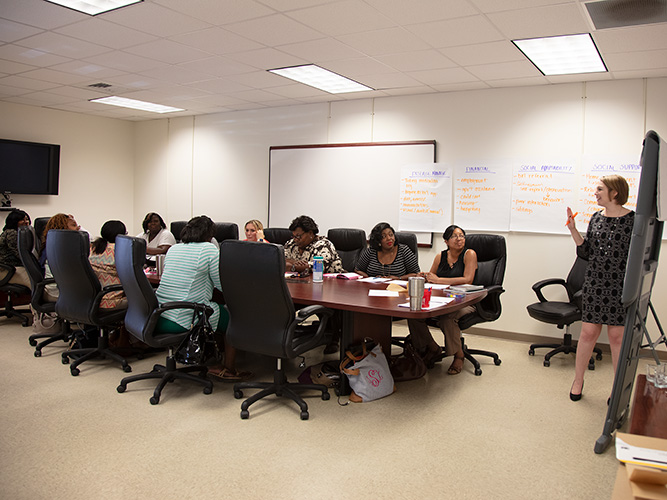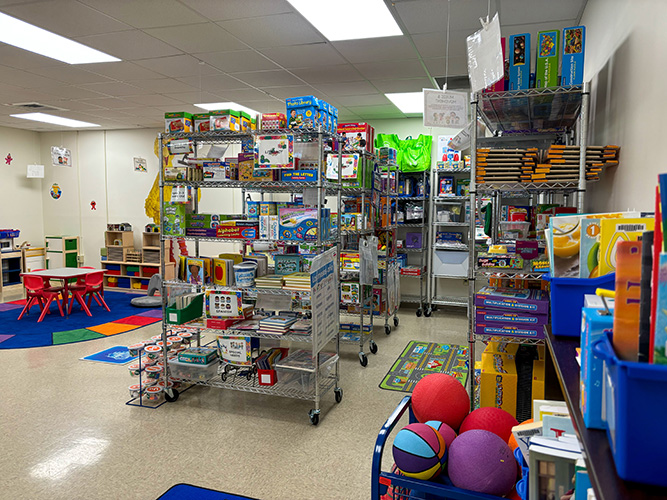Building Lasting Change: How Delta Health Alliance Sustains the Impact of Promise Neighborhoods
Written by: Karin Scott and Mikaela Tajo | Published: 01/10/2025
Balancing multiple grants with multiple timelines is a reality for many place-based initiatives, including grantees of the Promise Neighborhoods program. This program, administered by the U.S. Department of Education, provides multiyear grants aimed at improving educational outcomes for children and families. However, the program’s comprehensive vision—from cradle to career—means that goals such as enhancing graduation rates often extend beyond the standard 5-year grant cycle. While grantees have had opportunities for no-cost extensions and additional grants, they must find ways to maintain and sustain their Promise Neighborhoods mission without relying on federal funding.

Students in a Deer Creek Promise Community prekindergarten classroom.
Photo Credits: Rickey Lawson
Delta Health Alliance (DHA), one of the earliest Promise Neighborhoods grantees, has built a resilient model that uses strong partnerships, robust data and accountability systems, and a deep commitment to empowering families. Operating in the rural Mississippi Delta, DHA has embraced the challenge of sustaining impactful programs and infrastructure across the three geographic footprints that have been awarded Promise Neighborhoods funding—Indianola (awarded in fiscal year [FY] 2012, extension grant FY18), Deer Creek (FY16, extension grant FY22), and Leflore (FY21). Through its work, DHA demonstrates how thoughtful leadership and unwavering focus on community needs and strengths can overcome barriers and create meaningful impact.
In a conversation with their site liaisons, DHA leaders shared four strategies they have employed to sustain their initiatives and continue to promote positive outcomes. By implementing these strategies, DHA is able to maintain essential services and foster long-term resilience in the rural communities it serves, ensuring the organization continues to create meaningful change beyond the initial grant cycles.
Four Key Strategies for Sustainability
1. Maintain a Consistent Physical Presence in the Community
DHA staff emphasized the importance of maintaining a familiar presence in the community to accelerate community buy-in and participation in new programming.
The DHA building, once the heart of Indianola Promise Community’s (IPC) operations, now serves as a resource and referral (R&R) center. It continues to encourage connections among community members and offers a familiar environment because several IPC staff now work here.
Today, the Indianola R&R Center provides early childhood education resources, including books, toys, and diapers, while helping families access additional services from DHA and local partners. It also serves as a supply hub for teachers in the Mississippi Delta. By maintaining this physical presence, DHA draws on its established relationships and reputation, ensuring continued participation and engagement from the community.

Staff engage in a data coaching session in the IPC office in 2015.
Photo Credits: Matthew Johnson

The same space from left photo, transformed into the Indianola R&R Center in 2024.
Photo Credits: Rickey Lawson
2. Sustain Impactful Programming Through New Grant Opportunities
DHA integrates new grants to extend and enhance its programming. For example, funding from the Mississippi Department of Human Services supports the R&R centers across the region. The Indianola R&R Center continues to offer cradle-to-career programming, such as DHA’s Home Visitation Initiative. Between its opening in August 2023 and December 2024, the Indianola R&R Center has served 2,914 residents, including many who were once served by the Promise Neighborhoods initiative.
Maximizing funding through additional grants is critical to sustaining programs and meeting evolving community needs. By aligning new funding sources with existing efforts, DHA ensures continuity of services while avoiding disruptions that could hinder progress and impact. DHA is also working toward securing grant funding for telehealth services—which would be hosted in the R&R centers—to meet public health needs in the rural Delta. Staff shared that the grant writers think about “how to integrate [new grants] into current projects or something we already have—if there are any ways to fill in current gaps.” This proactive approach to funding sustains essential services and strengthens DHA’s capacity to innovate and respond to the unique needs of the rural community.
3. Build a Culture of Data-Driven Decisionmaking
DHA’s commitment to data-driven decisionmaking has been instrumental in maximizing program effectiveness and ensuring accountability. As a part of the program, grantees receive training and funding to develop their data and leadership infrastructure, such as the Annie E. Casey Foundation’s Results Count program, which focuses on equipping leaders with skills and tools to accelerate results and improve the well-being of children of families. Today, all DHA staff undergo Results-Based Leadership training, embedding a culture of continuous improvement across the organization.
DHA also employs the data-driven decisionmaking and infrastructure developed during the Promise Neighborhoods initiative. For example, staff at the R&R centers report on measures such as the number of toys and books checked out and event attendance—requirements not from the program’s funder but from DHA’s data-driven accountability approach. The approach enhances program effectiveness and ensures DHA identifies and sustains its most impactful programs.
4. Cultivate and Sustain Partnerships for Long-Term Impact
Strong and established partnerships are invaluable assets that provide crucial insights, connections, and resources, bolstering the sustainability of DHA’s efforts. DHA prioritizes building these relationships during grant-funded periods and actively maintains them afterward, ensuring continued impact even after funding ends.
For example, school partners in Indianola picked up DHA’s Families & Schools Together (FAST) program after the Promise Neighborhoods initiative and funding ended. FAST is a 10-week program designed to strengthen family bonds and build relationships between families, schools, and the broader community. While programming has evolved since DHA’s direct involvement, schools continue to engage parents to support family-school collaboration.
Key Takeaways for Sustaining Community Impact
Sustaining community impact is essential for Promise Neighborhoods grantees and all place-based initiatives. DHA’s experience provides a valuable framework: maintain a strong community presence, creatively leverage resources, use data for continuous improvement, and foster long-term partnerships.
The Promise Neighborhoods training and technical assistance team has developed resources to support grantees in sustaining their work beyond the grant cycle. Resources include briefs on sustaining critical infrastructure, guidance on leveraging partnerships, and best practices for maintaining data systems. Grantees use these tools to plan for long-term success while addressing the unique challenges their communities face.
Lessons learned from DHA’s approach, such as co-locating services, aligning funding strategies with community needs, prioritizing measurable outcomes, and building enduring relationships, can serve as a blueprint for other organizations facing similar challenges. Ultimately, DHA’s experience demonstrates that sustainability is about more than maintaining programs—it is about empowering communities to build lasting systems of support, ensuring the impact of the work endures for generations to come.